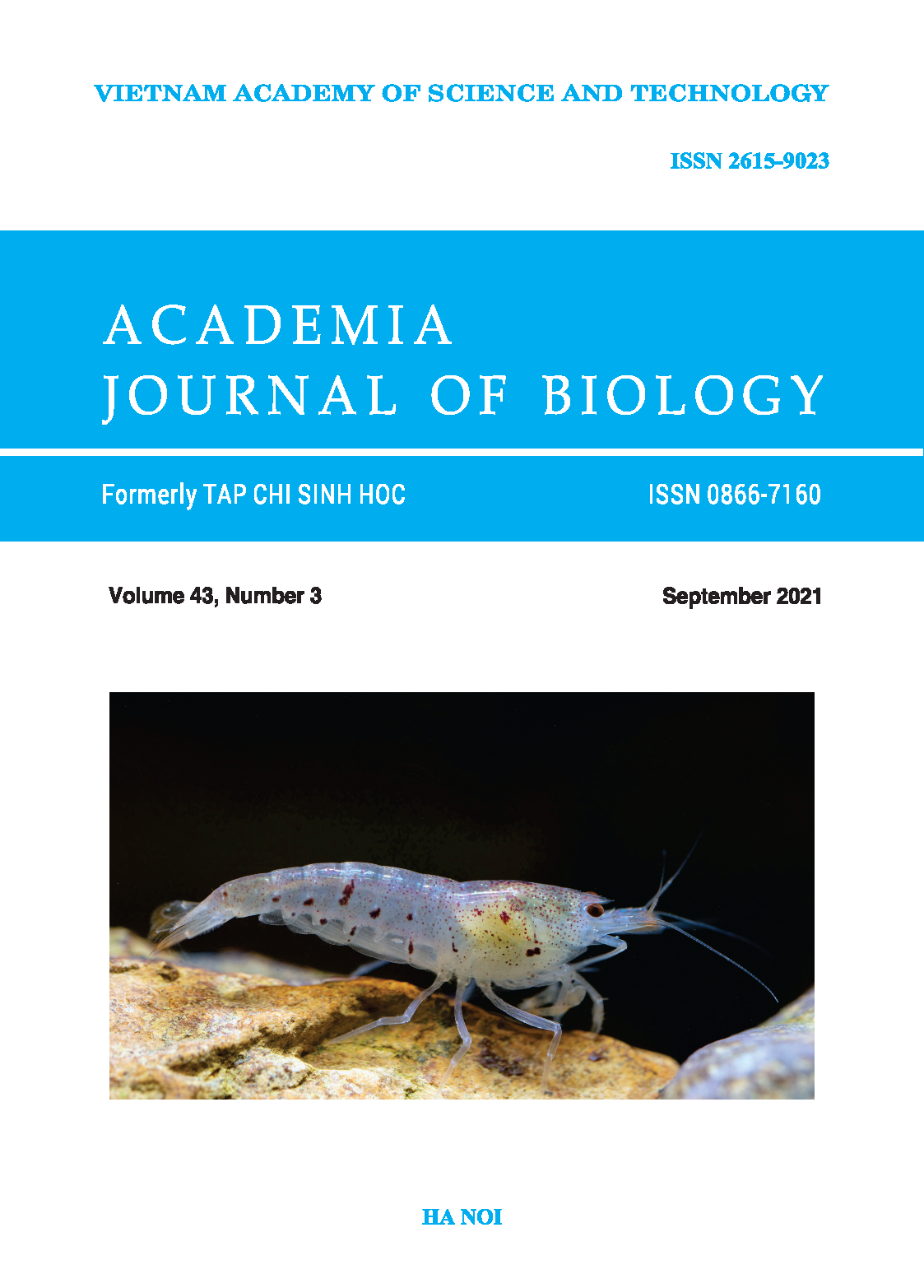Cloning and expression of \(\textit{ pigI}\) gene in \(\textit{Escherichia coli}\) BL21 (DE3)
Author affiliations
DOI:
https://doi.org/10.15625/2615-9023/15836Keywords:
MAP, MBC, pigI, prodigiosin, VietnamAbstract
Prodigiosin (Pg), a secondary metabolite with anticancer and antimicrobial activities, can be produced in Serratia marcescens bacteria through the condensation reaction of 4-methoxy-2, 2’-bipyrrole-5-carboxyaldehyde (MBC) and 2-methyl-3-amylpyrrole (MAP). Among these, the MBC synthetic pathway is started by the conversion of L-proline to L-proline-AMP before this complex is covalently attached to PigG. This reaction is catalyzed by an L-prolyl-AMP ligase named PigI. Therefore, PigI protein plays an important role in the prodigiosin biosynthetic pathway. However, studies related to PigI protein have not been carried out in Vietnam yet. In this work, the pigI gene was cloned and expressed in Escherichia coli DH10B and BL21 (DE3), respectively. Sequence alignment results revealed that the obtained pigI gene is 99.7% identical to the four strains, CP027798, CP027796, CP021984 and CP003959. This recombinant vector pJET1.2/pigI was used to reamplify pigI, and the acquired amplicon was inserted into pET22b vector at the site of HindIII and XhoI. The clone E. coli BL21 (DE3) containing the recombinant vector pET22b/pigI was expressed in an auto-induced medium. The presence of PigI protein in the lysate was identified due to a 53 kDa band through Western Blot analysis using an anti-his-tag antibody. The results of our study provide a potential method for producing prodigiosin from recombinant protein in Vietnam.
Downloads
References
Diaz-Ruiz C., Montaner B., Pérez-Tomás R., 2001. Prodigiosin induces cell death and morphological changes indicative of apoptosis in gastric cancer cell line HGT-1. Histol. Histopathol., 16(2): 415−421. https://doi.org/10.14670/hh-16.415
Domröse A., Klein A. S., Hage-Hülsmann J., Thies S., Svensson V., Classen T., Pietruszka J., Jaeger K.-E., Drepper T., Loeschcke A., 2015. Efficient recombinant production of prodigiosin in Pseudomonas putida. Front. Microbiol., 6: 972−972. https://doi.org/10.3389/fmicb. 2015.00972
Francisco R., Pérez-Tomás R., Gimènez-Bonafé P., Soto-Cerrato V., Giménez-Xavier P., Ambrosio S., 2007. Mechanisms of prodigiosin cytotoxicity in human neuroblastoma cell lines. Eur. J. Pharmacol., 572(2): 111−119. https://doi.org/10.1016/j.ejphar.2007.06.054
Han N., Ran T., Lou X., Gao Y., He J., Tang L., Xu D., Wang W., 2014. Expression, crystallization and preliminary crystallographic data analysis of PigI, a putative L-prolyl-AMP ligase from the prodigiosin synthetic pathway in Serratia. Acta. Crystallogr. F, 70(Pt 5): 624−627. https://doi.org/10.1107/S2053230X14005780
Harris A., Williamson N., Slater H., Cox A., Abbasi S., Foulds I., Simonsen H. T., Leeper F., Salmond G., 2004. The Serratia gene cluster encoding biosynthesis of the red antibiotic, prodigiosin, shows species- and strain-dependent genome context variation. Microbiology, 150(Pt 11): 3547−60. https://doi.org/10.1099/mic. 0.27222-0
Hong B., Prabhu V. V., Zhang S., van den Heuvel A. P. J., Dicker D. T., Kopelovich L., El-Deiry W. S., 2014. Prodigiosin Rescues Deficient p53 Signaling and Antitumor Effects via Upregulating p73 and Disrupting Its Interaction with Mutant p53. Cancer Res., 74(4): 1153−1165. https://doi.org/10.1158/0008-5472.can-13-0955
Klein A. S., Domröse A., Bongen P., Brass H. U. C., Classen T., Loeschcke A., Drepper T., Laraia L., Sievers S., Jaeger K.-E., Pietruszka J., 2017. New Prodigiosin Derivatives Obtained by Mutasynthesis in Pseudomonas putida. ACS Synth. Biol., 6(9): 1757−1765. https://doi.org/10.1021/ acssynbio.7b00099
Lapenda J., Silva P., Vicalvi M., Sena K., Nascimento S., 2015. Antimicrobial activity of prodigiosin isolated from Serratia marcescens UFPEDA 398. World J. Microb. Biot., 31(2): 399−406. https://doi.org/10.1007/s11274-014-1793-y
Montaner B., Navarro S., Piqué M., Vilaseca M., Martinell M., Giralt E., Gil J., Pérez-Tomás R., 2000. Prodigiosin from the supernatant of Serratia marcescens induces apoptosis in haematopoietic cancer cell lines. Brit. J. Pharmacol., 131(3): 585−593. https://doi.org/10.1038/ sj.bjp.0703614
Nguyen H. ,Nguyen K., 2015. Bioefficacy of Serratia marcescens isolated from entomopathogenic nematodes (EPN) and their secondary metabolite prodigiosin against Spodoptera litura. Science and Technology Development, 18.
Prabhu V. V., Hong B., Allen J. E., Zhang S., Lulla A. R., Dicker D. T., El-Deiry W. S., 2016. Small-Molecule Prodigiosin Restores p53 Tumor Suppressor Activity in Chemoresistant Colorectal Cancer Stem Cells via c-Jun-Mediated ΔNp73 Inhibition and p73 Activation. Cancer Res., 76(7): 1989-1999. https://doi.org/ 10.1158/0008-5472.can-14-2430
Rahul S., Chandrashekhar P., Hemant B., Bipinchandra S., Mouray E., Grellier P., Satish P., 2015. In vitro antiparasitic activity of microbial pigments and their combination with phytosynthesized metal nanoparticles. Parasitol. Int., 64(5): 353−356. https://doi.org/10.1016/j.parint. 2015.05.004
Sambrook J., Russell D. W., Russell D. W., 2001. Molecular cloning: a laboratory manual (3-volume set). Immunol, 49: 895−909.
Sumathi C. P., Mohanapriya D., Swarnalatha S., Dinesh M., Sekaran G., 2014. Production of prodigiosin using tannery fleshing and evaluating its pharmacological effects. The Scientific World Journal, 2014. https://doi.org/ 10.1155/2014/290327
Thanh N. ,Quyen L., 2015. Purification and antibacteria activity of anticancer agent prodigiosin from Serratia marcescens M10. Academia Journal of Biology: 37. https://doi.org/10.15625/0866-7160/v37n1 se.6112
Williamson N. R., Simonsen H. T., Ahmed R. A. A., Goldet G., Slater H., Woodley L., Leeper F. J., Salmond G. P. C., 2005. Biosynthesis of the red antibiotic, prodigiosin, in Serratia: identification of a novel 2-methyl-3-n-amyl-pyrrole (MAP) assembly pathway, definition of the terminal condensing enzyme, and implications for undecylprodigiosin biosynthesis in Streptomyces. Mol. Microbiol., 56(4): 971−989. https://doi.org/10.1111/j.1365-2958.2005. 04602.x
Downloads
Published
How to Cite
Issue
Section
License
Academia Journal of Biology (AJB) is an open-access and peer-reviewed journal. The articles published in the AJB are licensed under a Creative Commons Attribution-NonCommercial-NoDerivatives 4.0 International License (CC BY-NC-ND 4.0), which permits for immediate free access to the articles to read, download, copy, non-commercial use, distribution and reproduction in any medium, provided the work is properly cited (with a link to the formal publication through the relevant DOI), and without subscription charges or registration barriers. The full details of the CC BY-NC-ND 4.0 License are available at https://creativecommons.org/licenses/by-nc-nd/4.0/.












